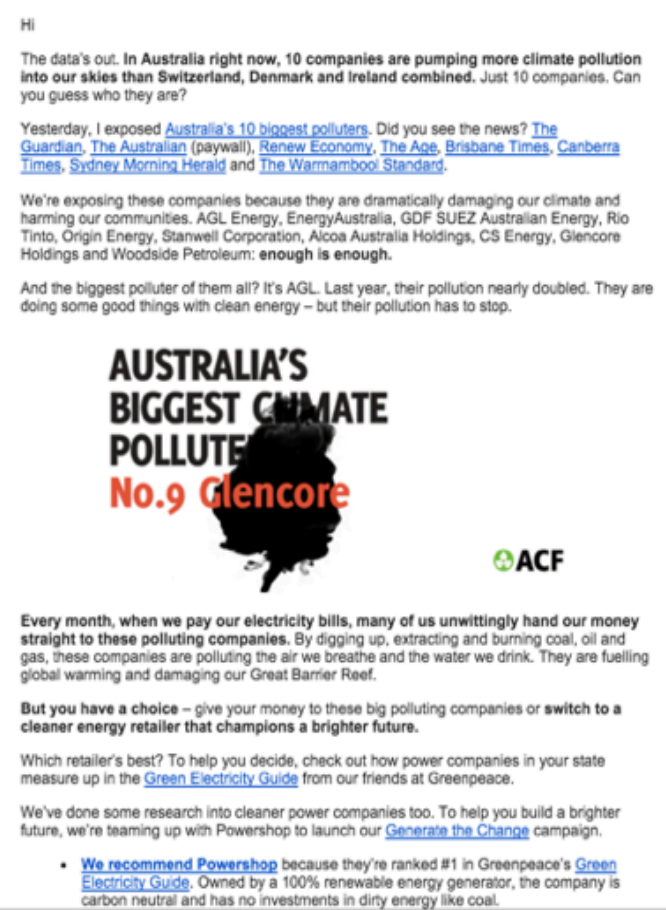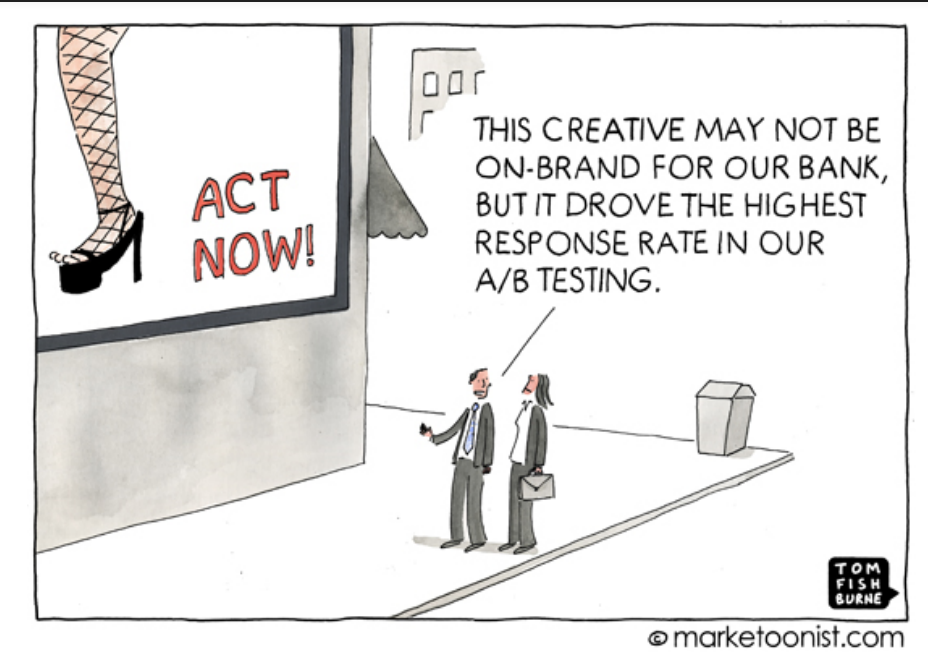By Organise Us
Email is the dominant engagement channel for most organisations. A well-designed email program should be at the heart of your communication strategy.
Introduction
For every 1,000 email subscribers, the average nonprofit has 428 Facebook fans, 141 Twitter followers, and 39 Instagram followers. On average, a nonprofit will reach just 8% of its fans on Facebook with a post that isn’t promoted.
Email offers a longterm relationship with your supporters (and their inbox). But know this:don’t treat your supporters’ inbox with respect and they WILL dump you!
On average, people receive 76 emails per day. Yes, they’re in multiple relationships with multiple organisations at any one time. Take them for granted or send them the same calling cards as their other dates? They’ll dump you as fast as they can hit the unsubscribe button!
Let’s take a look through our email behaviour:
- In 2016, Nonprofits sent 10% more email than 2015. On average, nonprofits sent 24 fundraising emails, 20 advocacy emails and 11 e-newsletters per subscriber.
- Advocacy email action rates average 1.6%. Open rates average 13% & click-through rates 1.91%.
- Fundraising email action rates average 0.05%. On average, nonprofits receive one donation for every 2,000 fundraising messages sent. The average donation is $36. Fundraising email open rates average 13% while click-through rates average 0.38%.
- Advocacy landing page completion rates average 74% and fundraising completion rates average 17%.
- Email accounted for 26% of all online revenue in 2016.
From who? Keep it PersonalAlmost two-thirds of readers open emails based on the “from” address, whereas only a quarter opened based on the subject line.
The person who “sends” the email from your organisation – the “from” address, and personalised name – needs to be recognisable and, ideally, reputable. Always use a personalised email that people can reply to. For example use: “[email protected]” not “[email protected]”.
Subject Lines
The first goal set by the Obama digital team during his election campaigns was to grab your attention long enough to get you to open the email. Toby Fallsgraff, Obama’s 2012 campaign email director explains, “The subject lines that worked the best were things you might see in your inbox from other people. ‘Hey’ was probably the best one we had over the duration.”
Consider the lifetime value of your supporter (and email list) and how they meet with your content, brand, story and actions.
The most effective subject lines evoke one or more of these themes and emotions:
- Self-interest
- Curiosity
- Novelty
- Urgency
- Humanity
- News
- Social proof
- Story
And how do you figure out what works? Test! Test! Test!

They Opened the Email. Now What?
Here are three core principles that form the basis of a successful email. (Success = the action you want them to take is taken).
1. Crisi-tunity
The crisi-tunity is what creates the tension in an email that leads the reader to act.
Just like a good story, an email needs tension to create a sense of momentum. “We’re working night and day to protect the earth”. What does this sentence lack? That’s right – tension.

Crisi-tunity
Lisa: “Look on the bright side, Dad. Did you know that the Chinese use the same word for ‘crisis’ as they do for ‘opportunity’?”
Homer: “Yes! Crisitunity.”
For example:
<crisis> Early this morning President Bush vetoed the expansion of the State Children’s Health Insurance Program, cancelling lifesaving care for over 3.8 million children. </crisis> <opportunity> But a large, bi-partisan majority of Congress strongly favours the health care expansion. If we speak out now, Congress could overturn Bush’s veto — restoring care for millions of children and ending Bush’s assault on the programs vulnerable Americans depend on. </opportunity>
2. Reader-Focused Theory of Change
By putting the supporter at the heart of the theory of change in the email, the reader is able to see how by taking the action, the change you are describing will actually happen. Paint a picture in which they can see themselves as a vital figure.
- This theory of change is too abstract and has no tangible urgency for the supporter
“Climate change threatens our very way of life.” - The supporter is completely missing in this theory of change
“Child poverty is terrible, and we’ve launched a petition to stop it.” - This theory of change is totally impossible
“Tony Abbott has staked his leadership on stopping the boats. So we’ve launched a petition to change his mind.”
3. Authenticity
Be authentic. Be genuine. Your supporters joined your cause for a reason. You are in a relationship with them based on shared values. Connect with them on that basis. Remind them how important they are. Make it about them and what we can do together, not just about you and what you need from them.

How to Structure an Email
Good email is highly structured. Good email is focussed. Good email creates a flow that engages the reader in the issue and inspires them to take the action you’ve designed.
After you’ve nailed the structure, and are following these simple principles, your email program will start writing itself.
- Establish a suite of ‘’active voices’’– campaign manager, CEO, the person closest to the action, trusted surrogates. Your email should come from a human.
- What’s your user-centred theory of change? Spell out why supporters should spend their time on this ask. Prove it’s plausible and worth it for them (not for us). It’s about “you”, “we” and “us” doing things – not them supporting x org to do things for them.
- Develop a tone that suits the voice of the organisation/issue – personal, casual, as if written to a friend, not formal.
- And remember – only use bolding to highlight key phrases of the text but not entire paragraphs. Italics can emphasise the odd word, be conversational.
A good email structure example:
[The Sender – First name, last name, org] Simon Bradshaw, ACF
[The Subject line – keep it short. Goal is to get email opened. One to eight words] Are you in?
[The Salutation – casual, first name, ‘Hi’ not ‘Dear’] Hi Tabatha,
[The Challenge – what’s the problem, refer to antagonist, what’s the barrier to change? Be succinct, aim to describe the challenge, solution and ask in 150 words before the first link. ] We knew it was coming. On Monday, a $10 million industry-funded “Say No” campaign will launch. This means a Say No advertisement running in almost every prime-time advertising slot. On top of this, sections of the media remain hostile when it comes to putting a price on pollution.
[The Solution – plausible, starts with us, share the strategy, include other protagonists/supporting actors] So, how are we responding? Before you say “not another rally!” don’t worry, we’re not repeating the same tactic. This is all about grassroots – our biggest strength and what the naysayers like to pretend they have, but don’t. We’ll be connecting with the community. We’re pretty sure people trust their friends and neighbours more than scare from mining magnates and shock jocks.
[The first link – needs to be visible without scrolling down. Should be a hyperlinked text, button or image] Are you with us? I’m in!
[The Ask – simple, key to the ‘solution’, winnable, believable theory of change] We’ve got community action planned across the country in August, starting with letter boxing our neighbourhoods. We want hundreds of you who are reading this email to volunteer to work with others to letterbox a neighbourhood. Are you in? [The second link – should be hyperlinked, active text like this can also be a friendly url link to copy & paste like this www.acfonline.org.au/I’m_In] I’m in.
[The Back up – why now, if not before? Further develop antagonist] We’re building a peak in our campaign bigger than the last, to show the depth of support for the price on pollution. And it’s happening soon – before our MPs return from recess to begin debating the package.
[Further illustration of the ask – personal stories, target, # of actions, urgency, deadline, show don’t tell] Can letter boxing make a difference? Check out this story from our “Camp Yes!” graduate, Jarren: “A friend came over last night. He told me when he arrived at work that morning, everyone was talking about the carbon tax. He was dragged over to the noticeboard to look at a letter. The letter had my name on it. One girl was so impressed by the letter that I’d delivered to her house, she took it to work and posted it up for everyone to see. Our boss read it, and loved it so much she requested all her employees go read it. This sparked up a big conversation in support of the carbon price.”
Will you join Jarren and letterbox in your neighbourhood? [The third link – repeat the link at the end of the email] I’m in.
[The Sign Off – use a friendly word like ‘Regards’ or a phrase like ‘Thanks for being part of this’, not formalities like ‘Yours sincerely’] We’ll support you all the way,
Simon Bradshaw,
Climate Team, ACF
[The PS – fresh take for a different audience, add a final link if possible] PS. Last week, you called for carbon capture to be kept out of the clean energy finance corporation. We flooded MPs with messages asking them to “keep it clean.” It worked! The $10 billion finance corporation could unlock $100 billion of investment in clean energy. [The fourth link – repeat the link at the end of the email] Let’s keep it up!
(Thanks to our friends at the Australian Conservation Foundation for this email structure example, and the one below.)
One Ask, One Email
This is your rule of thumb. One hand, one thumb. People’s time and attention are precious resources. Each email should be in the service of only one action.
Here is an example of an email with too many hyperlinks/asks:

That’s right – only ONE link destination, rinsed and repeated two or three times. More than one hyperlink destination? Ask yourself, why am I sending this email? What’s the ONE thing I want to engage my audience to do? Then ask them to do that one thing.
Your Best Friend: The A/B Test
A/B split testing is the comparison of two components with a single variation. A portion of your list receives one variation, the other portion receives another. The winning result is then sent to the full list.
Campaign communications can be fast and furious, but even in the frenzy of quick-turnaround actions, testing is still your friend.
When testing is baked into your daily work, you can optimise your content, and your conversion and engagement will be all the better for it. Testing will help you increase deliverability and keep your list active.
Make sure you are selecting your sample randomly from your list and only conduct one test at a time (one variable at a time – a subject, or an image test, not both) so you can be crystal clear on the winning variable.

But! Know when to ignore your test result!
The metrics (what you’re measuring) that you pay attention to will depend on the function of each email. First ask yourself: what’s the purpose of this email? To get your supporters to take an action? Raise brand awareness? Acquire a donation? Base what you’re testing on the desired outcome you want. You asked them to sign something – measure your action rate. You’re working on brand awareness – measure the open/click through rate.
Segment
A good, engaging email program segments every single email to a selected, defined list. How you segment your data list is dependent on a variety of factors that are unique to your supporter base and your goals.
Ask yourself:
- Who is your audience?
- Where on their journey are they with you?
- How will you meaningfully track engagement?
If you respect the individual and tailor your communications based on their engagement and activity with your cause, they will love you more!
Plan, Check, Check Again
You’ve drafted your email, looked at the data, segmented your list, tailored your content accordingly, and are feeling confident your email has a reader-focused theory of change with just one clearly defined ask/call to action.
Before you hit send!:
- Read your email out loud. You will hear mistakes you can’t see and improve your written conversational style.
- Develop an email draft, proof, approval process: use two different proof readers, reading the test email on different browsers, proof for final errors (not rewrites) before sending.
- Test all links.
- Preview your subject line.
- AB test? Send, wait, analyse, send highest performing email.
Remember – sometimes it will go wrong. Don’t panic. Instead, see if you can make your mistake work for you. Apologies can be a great opportunity to get real and personal with your supporter.
The apology email below is a great example from our friends at Greenpeace Australia Pacific. They turned a simple mistake – calling everyone the wrong name – into a follow up apology donation ask, that brought in more revenue!

They Said Hello, So Get Talking!
Consistency and frequency are vital aspects of a strong and productive email program. You’re building a relationship with your supporters, and like any relationship – they require you to be present.
An alarming number of Australian NGOs neglect their supporters and miss prime opportunities to connect with new subscribers.
Of a study of 105 Australian NGOs:
- 63% of organisations did not send a single email to new subscribers within the first 30 days of signing up.
- 96% of organisations did not send a welcome email, let alone a welcome series.
- Only 12% sent a new email subscriber a welcome series.
- 51% of organisations did not make a single ask in the first 90 days.
When people express their desire to be involved in your cause by signing up to be involved, and you follow through with a meaningful email program, you’ll be rewarded with an active and engaged community who actually open, read, donate and act on your emails.
Explore Further
Topics: Tags: Format: Language:

